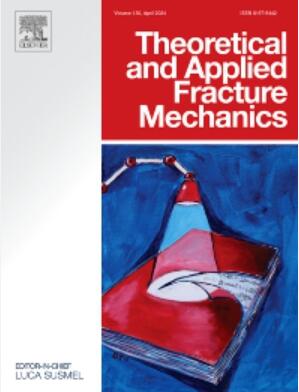Research on the effect of the spalling area and interfacial shear stress on fiber pullout behavior: Experimental and meso-mechanical analysis
IF 5.6
2区 工程技术
Q1 ENGINEERING, MECHANICAL
引用次数: 0
Abstract
This study investigated the pullout behavior of steel fibers with different curing ages (7, 14, 28 days) and inclination angles (0°, 30°, 45°, 60°), assessing the degree of matrix spalling as well as utilizing meso-mechanical model to evaluate the pullout behavior. The pullout load and average bond strength were maximum at 45° for different inclination angles, while the maximum pullout energy occurred at 60°. The spalling area of matrix was less influenced by curing age but was significantly affected by inclination angle, with the maximum spalling area occurring at 60°. An equation was provided to assess the relationship between spalling area and inclination angle. The degradation of interfacial shear stress determined the trend of descending branch (debonding stage), with the shape changing from concave to convex and the curvature of the convex shape gradually increasing with different curing ages and inclination angles. Expanding the value of shape coefficient from −0.1 to −0.05 and introducing an interfacial enhancement factor with a range of values from −8 to −2 can effectively evaluate the change of the interfacial shear stress, and the results of the numerical analysis were in agreement with experimental results.
剥落面积和界面剪应力对纤维拉拔行为的影响研究:实验和细观力学分析
研究了不同养护龄期(7天、14天、28天)和倾角(0°、30°、45°、60°)下钢纤维的拉拔行为,评估了基体剥落程度,并利用细观力学模型评价了钢纤维的拉拔行为。不同倾角下,拉拔载荷和平均粘结强度在45°时最大,而拉拔能量在60°时最大。基体的剥落面积受龄期影响较小,但受倾角影响较大,在60°处剥落面积最大。给出了剥落面积与倾角的关系式。界面剪切应力的退化决定了下降分支(剥离阶段)的趋势,其形状由凹变为凸,且凸形状的曲率随着养护龄期和倾角的不同而逐渐增大。将形状系数η从−0.1增大到−0.05,并引入界面增强因子b在−8 ~−2范围内,可以有效地评价界面剪应力的变化,数值分析结果与实验结果相吻合。
本文章由计算机程序翻译,如有差异,请以英文原文为准。
求助全文
约1分钟内获得全文
求助全文
来源期刊

Theoretical and Applied Fracture Mechanics
工程技术-工程:机械
CiteScore
8.40
自引率
18.90%
发文量
435
审稿时长
37 days
期刊介绍:
Theoretical and Applied Fracture Mechanics'' aims & scopes have been re-designed to cover both the theoretical, applied, and numerical aspects associated with those cracking related phenomena taking place, at a micro-, meso-, and macroscopic level, in materials/components/structures of any kind.
The journal aims to cover the cracking/mechanical behaviour of materials/components/structures in those situations involving both time-independent and time-dependent system of external forces/moments (such as, for instance, quasi-static, impulsive, impact, blasting, creep, contact, and fatigue loading). Since, under the above circumstances, the mechanical behaviour of cracked materials/components/structures is also affected by the environmental conditions, the journal would consider also those theoretical/experimental research works investigating the effect of external variables such as, for instance, the effect of corrosive environments as well as of high/low-temperature.
 求助内容:
求助内容: 应助结果提醒方式:
应助结果提醒方式:


